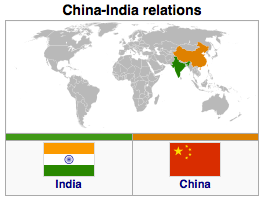China-India: Courting Closer Confidence – Analysis
By IPCS
By Swaran Singh
Indian Foreign Minister S M Krishna’s three day visit to Beijing follows the State Counsellor Dai Bingguo’s visit to India last month to participate in the 15th round of China-India Special Representatives border talks. The latter visit had resulted in the signing of a much-awaited new mechanism for dealing with frequent allegations of border incursions. The two sides are also reported on having exchanged written frameworks for the settlement of their disputed border which will be the basis for ultimately delineating a line on a mutually agreed map and then taking the line to the ground as their international border. This framework Agreement promises to open a new chapter in China-India relations and this hope marks the immediate backdrop of current visit by the Indian Foreign Minister.

Carrying this new positive spirit forward, the visit aims to increase the frequency of high-level visits. It seeks to smooth persistent mutual apprehensions about their equations as also to set the stage for President Hu Jintao’s impending visit to India to attend next month to participate in the BRICS summit being held in New Delhi on 29 March 2012. Given that the last BRICS summit was held in Beijing, the forthcoming summit brings a major opportunity for both these countries to demonstrate the strength of their mutual equations. This may well turn out to be President Hu Jintao’s last visit to India as President of China and compared to his predecessors, he will be remembered as one who visited India most frequently as also one of most travelld leader of China.
As for agenda of this visit by Indian Foreign Minister, the two sides will be discussing various specifics like how to balance their bilateral trade, strengthen their mutual confidence and accelerate frequency of their high-level visits. The two had begun talks for a Regional Trade Agreement (RTA) during the recent visit to China by India’s Commerce Minister Anand Sharma which may also be part of their deliberations. New Delhi, however, remains reluctant on RTA given its constantly rising trade deficit (expected to touch US$22 billion for 2011) and especially in view of two-thirds of India’s exports to China remaining primary products like iron ore and other raw materials.
The Indian side will be keen in exploring opportunities to expand access for its manufacturing and services sectors to China’s domestic markets. Discussions will be focused on how to open access to more Chinese cities for India’s IT, Agro and pharmaceutical firms. On the flipside, the case of two Indian traders accused of owing 10 million RMB to their Chinese business partners and currently involved in litigation in city of Yewu near Shanghai is also likely to come up for discussion. Even when Indian government keeps playing it down there have been serious concerns in India regarding China’s increasing assertiveness and these are often encouraged by assessments made in Western think-tanks and government. For example, in a prepared testimony before the Senate Select Committee on Intelligence recently, US Director of National Intelligence, James Clapper, talked of “India is increasingly concerned about China’s posture along their disputed border… and Indian military is strengthening its forces in preparation to fight a limited conflict along the disputed border…” which seems misplaced if not altogether mischievous.
The two sides will continue to discuss negotiations on building cooperation on various regional issues of immediate importance like maritime security and counter-terrorism. The two have indicated expansion beyond Gulf of Aden and towards Straits of Malacca. The two specific issues for discussions will be (a) evolving situation in Afghanistan and the role of neighbouring countries after much anticipated American exit from Afghanistan and (b) ever increasing western squeeze on Iran which remains a critical supplier of gas and oil to both these rapidly emerging Asian economies. The two sides are likely to reiterate their preference for diplomacy and their disapproval of any military action. There may also be discussion on Syria and on Arab Spring in general where the two sides do not share identical strategies.
The two sides will also try to fine tune their worldviews on likely trajectories and impact of continuing global economic crisis, develop a common stance on climate change negotiations and energy security as also other such larger issues that remain critical for their peaceful development. In this regard, the high-point of this visit will be Indian Foreign Minister calling on President Hu Jintao and Vice President Xi Jinping who will succeed Hu Jintao later this year. This meeting may facilitate a possible visit by Xi Jinping to India which has also been on agenda of recent China-India deliberations. This will make it the first visit of its kind by a designated next leader of China and help sustain the trend of visits set by President Hu Jintao.
Finally, the Foreign Minister will also be inaugurating the expanded and refurnished chancery of the Indian Embassy meant to cater for the increased two-way traffic which marks another positive sign of ever expanding China-India interactions which have since moved way beyond parlays by State officials.
Swaran Singh
Professor, Diplomacy & Disarmament, CIPOD, JNU
email: [email protected]
